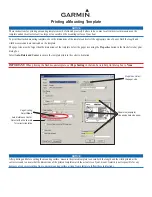
11
12
Tips & T
ricks
Do's & Don'ts
PLEASE READ THIS GUIDE THOROUGHLY & VISIT OUR WEBSITE FOR ADDITIONAL INFORMATION.
www.cetaceasound.com
Tips & Tricks
Tip:
Preventing Inadvertent Feedback
Once you are comfortable using the CVS96 and the Cetacea Sound speaker, here is a tip that
will help prevent inadvertent feedback. Turn the volume control on the receiver all the way down.
Select the LOW range sensitivity on the Transmitter. Stand in an area of the room where you
will be doing most of your speaking. Have someone help you slowly turn up the volume on the
receiver until feedback is heard or the volume becomes too loud, whichever occurs
fi
rst. This is
the maximum volume level that can be used in this particular room. Now ONLY use the “MUTE”
switch on the transmitter to turn the microphone down when desired. Leave the volume control
set where it was previously as long as you are in this room.
In the case where the
fi
rst adjustment is not loud enough, repeat the same procedure with the
sensitivity switch in the MID or HI position.
Tip:
Spend time practicing in the area of the room where you will be speaking. Listen for any
unwarranted noise or feedback as you walk the room and avoid those noisy areas that cannot be
eliminated by equipment adjustments.
Tip:
Let your presenters and teachers try out a variety of microphone styles by offering a selection
for them to choose from. In our experience, everyone has a preference. Enabling your presenter
with a microphone that suits her style will not only allow for proper presentation skill development
but also ensure the highest quality presentations and lectures.
Please visit our website for a list CVS96 "Tips & Tricks":
www.cetaceasound.com/literature/tips/lit-tip-microphones.html
Do's & Don'ts
Don't
attempt any repairs on your own.
Don't
pull or in any way fold, crimp or tightly coil the microphone wire.
Don't
plug anything into the receiver jacks except the source you were trained on. If using a
computer for recording, be careful! The backs of some sound cards have powered jacks that
can damage your receiver. These types of failures are not covered under warranty.
Don't
use alkaline batteries and then place the transmitter or receiver into the charging base.
It could permanently damage the base or other components.
Do
educate all users in the proper use and handling of electronic equipment,
especially microphones.
Do
have frequent user meetings to discuss issues and concerns.
Do
adjust speaker volume to a comfortable listening level. It should not sound
loud to the presenter.
Do
loosely coil microphone wires, when not in use.
Please visit our website for additional CVS96 "Do's & Don'ts":
http://cetaceasound.com/literature/dos/lit-do-microphones.html


























